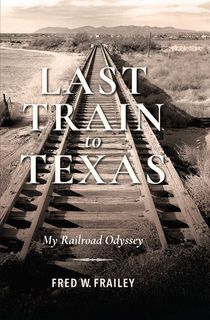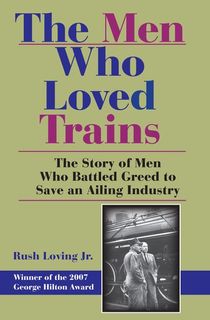In 1827, the Baltimore and Ohio Railroad was granted a charter to transport both freight and passengers. It was the first U.S. company to receive these permissions. It had a rocky start (their steam engine actually lost a race to a horse in 1830), but it ultimately became one of the most prosperous railways in the United States. Railroads would go on to spider across the country, connecting remote settlements in the mid- and far-West to the more established East and Southern parts of the United States. By 1866, the coasts were connected by the Union Pacific and Central Pacific railroads.
Railroads would play a pivotal part in the American Civil War, allowing the Union to both send troops and supplies, as well as cut off crucial materials needed by the Confederacy. The Golden Age of the railway would stretch from 1830 to 1930. This age was ended by the Great Depression, when employment and investment in railway maintenance were sharply cut.
We’ve rounded up 10 books detailing the innovations, successes, and in some cases, the disasters that have marked the industry since its establishment in America.

Hear That Lonesome Whistle Blow
Tracking the origins of the American railroad system, historian Dee Brown considers the disparate communities spread across the American Midwest and the frontier. Everything changed when along came “the demonic power of the Iron Horse and its bands of iron track,” with its ability to interconnect vast and isolated regions. While Brown’s book looks into the marvel that was the early railway system, it also examines the darker aspects of its conception, including the destruction of ecosystems and Native Americans' way of life.
Related: These Native American History Books Shed New Light on the Past and Present

Targeted Tracks
The American railroad was growing in earnest in the 1830s, and it was well established by the time of the Civil War. This book focuses primarily on the Cumberland Valley Railroad, which was a critical resource for the Union Army, and a subsequent target for the Confederacy. Authors Mingus and Wingert use various historical accounts—diaries, newspapers, letters, official reports—to trace the strategic involvement and disruption of the railroad throughout the course of the war.
Related: 6 Reasons the Union Won the American Civil War

History of the Louisville & Nashville Railroad
The Louisville & Nashville Railroad spearheaded rail systems and transcontinental travel in the South after the Civil War. The L&N would go on to endure through the Great Depression, both World Wars, and numerous natural disasters. This newest edition of Maury Klein’s seminal classic on railroad history includes an updated introduction by Klein, outlining the recent history of the Louisville & Nashville line since the book was first published in 1972.

Last Train to Texas
Drawing from primary source accounts, veteran railroad columnist Fred W. Frailey brings interesting insight to the history of American train travel. In his examination, Frailey draws anecdotes from his wide industry experience. He frames the railroad’s history by examining the people that built it, and in doing so, brings the reader along a humorous and informative ride.

Railroads and the American People
This book examines the social impact of the railroad during the Golden Age, from 1830 to 1930. H. Roger Grant delves into four key topics essential to this piece of social history: trains and travel, the stations, railroads and the communities surrounding them, and the legacy of the railroad in America. This book looks at the lasting impact that the railroad had on American life, from the cities that relied on them, to the stations and depots that thrived and became the center of their communities.
Related: 13 Remarkable Books About the Great Depression

The Wreck of the Old 97
On September 27th, 1903, Fast Mail train No. 97 plunged off a 45-foot trestle and into the ravine below it. The train derailed as a result of excessive speed in an attempt to keep it on schedule—according to legend, the engineer swore to “put her in Spencer on time” or “put her in Hell.” This disaster inspired the ballad “Wreck of the Old 97." The song cemented the tragedy’s place in American folklore. This book uses court testimony and eyewitness accounts to glean an accurate picture of the day’s events, as well as the controversial reception of the famed ballad.

The Greatest Railroad Story Ever Told
The Greatest Railroad Story Ever Told recounts the vision of a daring railroad magnate and visionary that brought the railroad to the southernmost reaches of the East Coast. Henry Flagler extended the Florida East Coast Railway to “the nearest deepwater American Port.” Seth Bramson traces the impact of Flagler’s work and vision and the lasting changes that he made on the railroad industry, as well as the development of the Florida Keys.
Related: The Greatest History (and Beyond) Books for Dads of All Types

The Men Who Loved Trains
This work chronicles the men who have loved and led the railroad. The motives of these men vary from passion for the industry to the wealth lining their own pockets. Considered an excellent resource for both railroad aficionados and American history enthusiasts, The Men Who Loved Trains tells the captivating tale of the reshaping of the railroad industry in the Northeast.

Iron Women: The Ladies Who Helped Build the Railroad
Going as far back as 1838, women have had a hand in working on the railroad. While they were not responsible for building railways, they did play a key role in its operation. The history of the railroad is intertwined with innovative women that worked on trains, helped to improve the mechanics of the train cars, and maintained the conditions of the railways. They were also hired as nurses or stewardesses in passenger cars, ensuring the comfort and wellbeing of passengers during their journeys.
Related: 30 Biographies of Remarkable Women That You Need to Read

Iron Empires
The completion of the Transatlantic Railroad in 1869 resulted in socioeconomic shockwaves that no one had anticipated. Magnates like Cornelius Vanderbilt and J.P. Morgan sought to further their empires, leading to volatile stock market activity. This revolutionary shift to the nation’s geography had ramifications for people at every level of the economic sphere. Delving into four decades of this national shuffle and drawing on the actions of some of the well-known figures of the Gilded Age, Michael Hiltzik draws the reader into the conflicts of the robber barons and the lasting effects on business and legislation.
This post is sponsored by Open Road Media. Thank you for supporting our partners, who make it possible for The Archive to continue publishing the history stories you love.

